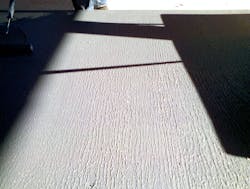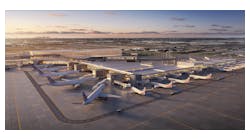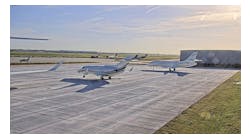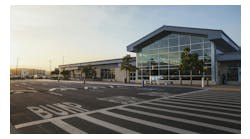In an airport, as in any commercial or municipal facility, coatings have an important job to do. Sure, they make whatever substrate they’re applied on – typically concrete or steel – look good. But they do much more than that.
When properly specified and applied, coatings save your facility a great deal of money.
Corrosion and wear are a constant threat to the assets and infrastructure at any airport, from the jetways and hangars to the interior floors and even the building structure itself. Protecting these assets is important from a cost and longevity standpoint.
The right coatings can extend any asset’s useful life by five, ten, even twenty years. That means equipment and infrastructure doesn't need to be replaced or repaired as often, and that results in savings that far outpace the cost of the coatings themselves.
There are also liability concerns, as worn out or failing equipment and infrastructure can cause damage to other equipment and potentially injuries to people.
Coatings are crucial, but not all coatings are alike; understanding and specifying the right coatings is key. Different formulations are available to meet the specific needs of surfaces in the various areas in an airport. To help make sure you are covered, below is a summary of the coating system recommendations for the major areas found on an airport.
Public Areas
In concourses, terminals and other areas used by the public, aesthetics is the top concern. Many airports have found concrete floors to be a viable, affordable alternative to terrazzo, which can cost several times that of a coated or polished concrete floor.
These floors endure a surprising amount of punishment. Dropped items, spills, broken luggage, moderate wheel traffic, and constant foot traffic can take their toll on any surface. Despite being indoors, these floors are also subject to ultraviolet damage from sunlight streaming in through large windows.
To get this kind of protection while ensuring the floors maintain their looks and are easy to clean, a very basic option is a lithium silicate densifier. This helps the polished surface last longer while also providing a glossy, high-traction finish.
For a far more professional look, there are several epoxy/topcoat options with or without broadcast media that offer an aesthetically pleasing, refined look. Flake broadcast finishes offer endless design possibilities, with different combinations of flake sizes and colors.
For a more refined, subtle look, microtech flake broadcast finishes have small speckles that can mimic terrazzo and other high-end materials. Or, for a bolder design, there are metallic pigment coatings offering a deep, distinctive, attractive luster.
Non-Public Areas
The areas used by airport staff and equipment are varied, ranging from loading docks to baggage handling to security. In these areas, aesthetics is of little concern, but safety and durability are paramount.
Coatings need to first protect the people that work on them by helping prevent slip-and-fall accidents. In many cases, they need to protect the concrete surface from moisture, road salt, oil and chemical spills.
Here, a two-step process is recommended, starting with a concrete sealer and primer. Depending on the location and use of the floor, this would either be a solvent-based urethane or a water-based epoxy.
Finishing the floor might be as simple as adding a clear or pigmented coating. But in areas where traction and especially non-slip is important, a safety grip coating is recommended. Numerous grades of slip-resistant coatings are available, from modest to very aggressive, like those found on aircraft carrier decks. Some offer UV and chemical resistance, as well. This may be extreme for a land-based airport, but it illustrates the choices available.
When coatings need to be applied in areas that must remain occupied, there are low- or no-VOC formulas, so they can be applied without vacating the facility.
As in public areas, the coating that’s most appropriate depends upon the specific need of the environment.
Hangars
They might not look it, but airport hangars are some of the most punishing environments for concrete floors. Jet aircraft hydraulic fluid is extremely corrosive, while fuel, oil and ultraviolet light also compromise the long-term durability of the floor’s look and function.
Add to that tire marks from hot aircraft tires and frequently dropped tools, and you get the picture of challenges in making a well-done, durable hangar floor.
Most airport facility professionals want hangar floors to be very high-gloss and easy to keep clean. Accomplishing that requires a specialized coating system, starting with a primer/sealer, as mentioned above.
In these cases, consider a midcoat. For hangars primarily used for storage of light aircraft, thin film midcoats are added that will typically provide sufficient abrasion, chemical and UV resistance.
But in hangars for heavier aircraft and maintenance, you’ll want to consider a sand broadcast pigmented midcoat. This provides added protection from tire marks and heavy items being dropped.
For the topcoat, a specialized urethane retains the color and high-gloss finish, while providing additional protection from tire marks, chemicals and UV.
Exterior
As in non-public areas, the specific needs for coatings on an airport’s exterior are as varied as their uses. Parking structures, walkways, exposed steel, and exterior walls all have very different needs.
These needs also vary by the climate. Airports in areas prone to wet, icy conditions have very different needs than those in more temperate or hot, dry weather zones.
One of the areas where coatings are especially important is parking structures, which have to endure not only heavy vehicular traffic, but also the effects of water intrusion and often road salt.
In these environments, water-based, low-VOC concrete sealers are recommended. Sealers like these are designed to withstand the elements while maintaining the look of the concrete. And, because parking structures need to be re-coated on occasion, their fast curing time means the surface is ready for use quickly.
Another option, is a spray-applied polyurea. This is a thick-film elastomeric coating spray-applied with heated, high-pressure equipment. It has a very fast cure time, ready for foot traffic in under an hour and typically ready for vehicular service is just a few hours. Because these finishes require specialized surface preparation and application equipment, they’re typically only cost-effective in very large areas, but they can act as effective water-proofing membranes for many years.
Airport Structures
Concrete floors aren’t the only surfaces that benefit from the protection of coatings. Steel structures, jetways, and interior and exterior concrete surfaces all have special coating needs.
Many airports feature exposed steel beams and components on both the interior and exterior of the building. Typically, structural steel is painted prior to and during the original construction of the building. Given time, however, they begin to show the effects of UV and especially corrosion, if the structures are outdoors.
Recoating infrastructure steel is a specialized and expensive process, so durability is the primary concern. The best coatings are those that will last decades, which is why a urethane topcoat is typically recommended instead of epoxy. While both will work, urethanes or the more expensive fluoropolymer products offer years-longer service without chalking, fading or intrusion of corrosion.
Applied to either steel or concrete, urethane topcoats provide superior resistance to weather-related corrosion. However, there is another corrosive problem that affects some airports. Vandals.
If you have a graffiti problem, there are specialized urethane coatings available that can be cleaned with aggressive solvents like acetone and MEK without damage to the topcoat. You’ll clean away the spray paint yet keep the original glossy, colorful look afforded by these topcoats.
Unlike other commercial facilities, airports and transportation terminals have a lot of different areas and zones that house very different, specialized processes. No one coating can provide the aesthetics, ease of maintenance, safety and durability for every zone.
Although you may never be directly involved in the specification of coatings at your airport, the more you know about the capabilities different coatings have, the better you’ll be able to ensure your airport is covered.
Lou Frank is a recognized expert in the coatings industry, notably as the founder of CoatingsPro magazine, an industry-leading publication now owned by NACE International. Today he leads CFI’s business development efforts. Frank has a business degree from the University of Maryland and is a NACE Coatings Inspector.






